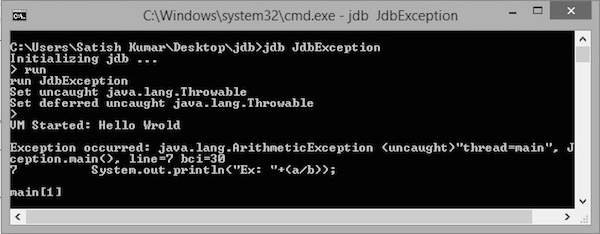This chapter explains how to handle the exception class using JDB.
Generally, whenever a program raises an exception without a catch
statement, then the VM prints the exception line, the cause of the
exception, and exits.
If the exception has been raised with a catch statement, then the exception is handled by the catch statement. Here, the VM prints the output with the cause of exception.
When the class that raises the exception is running under JDB, it also throws the uncaught exception. That exception can be handled using the catch command.


If the exception has been raised with a catch statement, then the exception is handled by the catch statement. Here, the VM prints the output with the cause of exception.
When the class that raises the exception is running under JDB, it also throws the uncaught exception. That exception can be handled using the catch command.
Example
Let us take an example of the class JdbException:public class JdbException { public static void main(String ar[]) throws Exception { int a=8, b=0; System.out.println("Welcome"); System.out.println("Ex: "+(a/b)); } }Save the above file with the name JdbException.java. Compile this file using the following command:
\>javac JdbException.javaFollow the steps given below to handle the exception.
Step 1: Run the Class
The following command executes the class named JdbException as follows:\>jdb JdbException >runThis JdbException class contains an exception, hence you get to see the following output:

Step 2: Catch the Exception
The following command catches the exception:mian[1] catch java.lang.ArithmeticExceptionIt will give you the following output:
Set all java.lang.ArithmeticException
Step 3: Continue Execution
The following command continues the execution. Now the catch handles the arithmetic exception as follows:

No comments:
Post a Comment